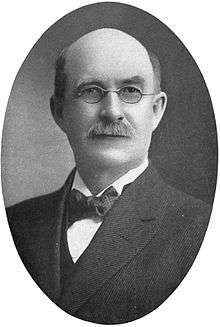Edward Angus Burt
| Edward Angus Burt | |
|---|---|
 | |
| Born | April 9, 1859 |
| Died | April 27, 1939 (aged 80) |
Edward Angus Burt (April 9, 1859 – April 27, 1939) was an American mycologist and an authority on the Thelephoraceae family of resupinate (flat on the substrate) fungi.[1][2] He received his M.A. in 1894 and Ph.D. in 1895, both from Harvard University under William G. Farlow and Roland Thaxter.[2] He became Professor of Natural History at Middlebury College in 1895, then both Professor of Botany at the Henry Shaw School of Botany at Washington University and mycologist for the Missouri Botanical Garden in 1913.[2] He also worked on a systematic description of basidiomycetes such as Merulius and fungi from Vermont, Siberia, and Java.[2]
The Septobasidium species S. burtii is named in his honor.[3] [4]
References
- ↑ Farlow Herbarium, Harvard University, Farlow Herbarium
- 1 2 3 4 EDWARD ANGUS BURT PAPERS (1895-1926), New York Botanical Gardens
- ↑ Septobasidium burtii, MycoBank
- ↑ Henk, D. A.; Vilgalys, R. (2007). "Molecular phylogeny suggests a single origin of insect symbiosis in the Pucciniomycetes with support for some relationships within the genus Septobasidium". American journal of botany. 94 (9): 1515–1526.
- ↑ IPNI. Burt.
This article is issued from Wikipedia - version of the 8/16/2016. The text is available under the Creative Commons Attribution/Share Alike but additional terms may apply for the media files.